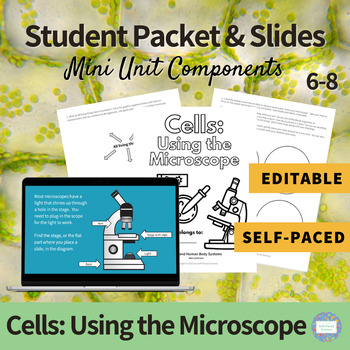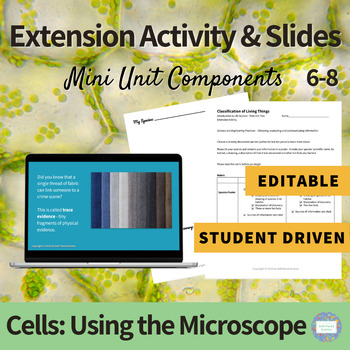Cells: Using the Microscope - A Complete Mini Unit for Middle School MS-LS1-1
- Google Drive™ folder

Products in this Bundle (3)
Also included in
- This complete Cells and Body Systems unit has everything you need to teach NGSS MS-LS1-1, MS-LS1-2, MS-LS1-3 and MS-LS1-8 including editable student slides, packets, hands-on investigations, final projects and extension activities. Topics covered include using the microscope, cells and organelles,Price $60.00Original Price $72.00Save $12.00
Description
This Cells: Using the Microscope mini unit has everything you need to meet NGSS MS-LS1-1 including editable student slides and packet, hands-on investigations, a final project, extension activity and content vocabulary posters. Topics covered include a review of the characteristics of life, how to use a microscope, pond life drawings and prokaryotes vs. eukaryotes.
Students first review the characteristics of living things, learn about the parts of a microscope and basic safety rules to follow. They view pond water with a scope, practice drawing detailed observations and distinguish between prokaryotes and eukaryotes.
In the summative assessment, students view living and nonliving specimens under the microscope (pond water protists, onion root tip, salt, sugar), sketch their observations and argue if their specimen is living or nonliving.
Finally, kids get to use their knowledge of microscopy to solve a crime! Students compare fabric fibers and solid powders left at a crime scene with evidence samples from four suspects. This is a great way to engage students using CSI skills in a light-hearted and fun way!
This mini unit can easily be used for blended learning - a combination of individual digital learning, hands-on investigations, whole class mini lessons and mastery based assessments that students move through at their own pace. If you want to decrease stress for yourself and your students and help kids make personal connections to the science they are learning, try this self-paced mini unit!
We use scientific language in context with photographs and graphics to make our lessons accessible to readers of all levels. Students make personal connections to the science they learn and enjoy our highly engaging authentic assessments.
Our lessons are written to make self-pacing as simple as possible and also work in a traditional classroom.
When you purchase this product, TpT will copy these files directly to your Google Drive:
Student Packet and Slides:
→ Teacher outline (PDF)
→ Student slides (Google Slides)
→ Student packet (Google Docs) with answer key (PDF)
→ Content vocabulary posters (PDF)
Student Project:
→ Teacher outline (PDF)
→ Summative assessment with rubric (Google Docs)
Extension Activity:
→ Teacher outline (PDF)
→ Extension activity slides (Google Slides)
→ Extension activity with student rubric (Google Docs)
All Google Docs and Slides are editable to better meet your specific needs.
Materials needed for this unit are listed below and can be easily modified for what you have on hand:
- 1:1 technology OR printed copies of student slides and packet for each student, colored pencils
- Pond water, aquarium water, onion, carrot, celery
- Microscopes, slides, coverslips, eye droppers
- Iodine and/or methylene blue to stain cells (optional)
- Four types of fabric, forceps, Ziploc bags, salt, sugar, cinnamon
How much time will this mini unit take?
Depending on the rate your students work, this mini unit will take between six and ten days to complete.
Why would I want to self-pace my science class?
If you are tired of cramming learning into perfect 48 minute chunks or filling that extra 10 minutes of class with busy work or if your students get stressed when the bell rings as they rush to finish a lab, then self-pacing is for you!
Self-pacing creates a relaxed, stress-free learning environment for both students and teachers and supports everyone’s social and emotional needs.
Teachers trade whole class lectures for one-on-one conversations and students spend their time doing science at the pace that is right for them!
Our self-paced science lessons foster independence and higher order thinking while providing many opportunities for students to practice science and engineering skills. The three dimensions of NGSS (science and engineering practices, crosscutting concepts, disciplinary core ideas) are embedded throughout our lessons and units.
This Cells: Using the Microscope mini unit is also a part of the Cells and Body Systems Bundle.
You might also be interested in these Self-Paced Science products:
- Earth and Space Science Complete Curriculum
- Evidence of a Chemical Reaction Mini Unit
- Digital and Analog Signals Waves Mini Unit
Visit our Self-Paced Science store to view all of our products.
Copyright © Self-Paced Science. All rights reserved.
Permission to copy for single classroom use only.
Please purchase additional licenses if you’d like to share this product.






